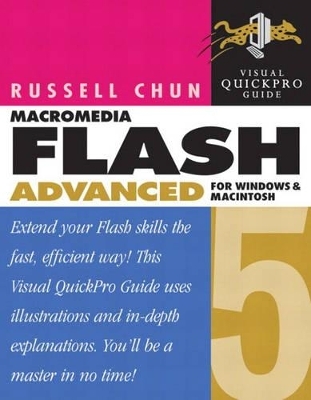
Flash 5 Advanced for Windows and Macintosh
Peachpit Press Publications
978-0-201-72624-4 (ISBN)
- Titel erscheint in neuer Auflage
- Artikel merken
Looking for guide to Macromedia Flash that goes beyond the basics? You're not alone. This popular software has generated an enormous demand for advanced Flash titles, but most third-party books offer limited instruction in Action Scripting and Movie Clips--essential functions for complex Flash interactivity.
Well, look no further than Flash 5 Advanced for Windows & Macintosh: Visual QuickPro Guide. This is not your typical cookbook-style guide with examples for users to copy. Instead, this thorough reference covers the advanced features and techniques of Flash, and demonstrates ways to approach animation and interactivity, encouraging you to "think" in Flash. The book covers five main topics: advanced animation, understanding ActionScript, navigation, transforming graphics and sound, and working with information, and uses the same task-based, visual reference format of the Visual QuickStart Guide series.
Russell Chun is the Art Director/Media Development Editor for Addison-Wesley Longman, where he develops instructional animations and illustrations for print and new media.
Introduction.
What's New in Flash 5. Who Should Use This Book. Goals of This Book. How to Use This Book. What's on the CD.
I. APPROACHING ADVANCED ANIMATION.
1. Building Complexity.
Combining Techniques and Using Layers Effectively.
(Talk about General Strategy, Offer Demo of Archaeopteryx or Urey-Miller Animation).
Motion Tweening Strategies. Creating Seamless Animated Loops.
To Make a Closed Path Motion Guide. To Create a Continuous Scrolling Graphic.
Using Multiple Guided Layers.
To Assign a Second Guided Layer to a Guide Layer. To Vary the Timing of a Second Guided Layer. To Offset a Second Guided Layer. To Add Local Variations to Multiple Guided Layers.
Shape Tweening Strategies. Using Shape Hints.
To Add a Shape Hint. To Delete a Shape Hint. To Remove All Shape Hints.
Using Intermediate Key Frames.
To Create an Intermediate Keyframe. To Use Shape Hints across Multiple Keyframes.
Using Layers to Simplify Shape Changes.
To Separate Complex Shape Changes.
Animating Your Masks.
To Tween the Masking Layer. To Create a Soft-Edged Mask. To Tween the Masked Layer.
Text Effects.
2. Working with Video and 3D.
Integrating Flash and QuickTime.
To Import a Quicktime Movie. To Change the Path of the Quicktime File. To Edit a Quicktime Movie.
Rotoscoping.
To Copy the Motion of a Quicktime Movie. To Reduce the Number of Available Frames.
Simulating Video.
To Create Sequential Bitmaps From a Quicktime Movie. To Convert the Bitmaps into Simplified Vectors. To Use the Traced Animation.
Simulating 3D.
Third Party Applications. To Create a 3D Rotation.
II. UNDERSTANDING ACTIONSCRIPT.
3. The Language of Object-Oriented Scripting.
About Classes, Objects, Methods, and Properties. Writing with Dot Syntax. More Punctuation. The Actions Panel. Using Comments. Using Objects. Creating Instances of Objects (Constructor Functions). Creating Custom Objects. Generator Objects?
III. NAVIGATING TIMELINES AND COMMUNICATING.
4. Advanced Buttons and User Input.
Invisible Buttons. Animated Buttons. Tweening Buttons. Event Handlers: Mouseevents and Clipevents. Key Object and Keycodes (Appendix B).
5. Communicating within Flash.
About the Movie Clip Object and Navigating Timelines. Naming Instances and Target Paths. Using “With” and Evaluate to Call Methods. Using “This,” “_Root,” and “_Parent.” Movie Clips as Containers. Preloaders, Simple and Complex.
6. Communicating outside Flash.
Communicating with the Browser (Get URL, CGI Get/Post). XML Support (Sidebar). Generator Templates. Communicating with External Swfs (Load Movie). Levels. FS Command for Projectors. Printing.
IV. TRANSFORMING GRAPHICS AND SOUND.
7. Controlling the Movie Clip.
Drag Movie Clip. Duplicate and Remove Movie Clip. Getting and Setting Movie Clip Properties. Modifying the Movieclip Color (Color Object). Collision Detection (Hittest) and Drop Target Detection. Customizing the Cursor (Hidemouse). Locating the Cursor (_Xmouse, _Ymouse). Collision Detection with the Mouse Cursor.
8. Controlling Sound.
Sound Object. Attaching Sounds. Playing Sounds. Modifying Sounds. Building a Sound Library.
V. WORKING WITH INFORMATION.
9. Controlling Information Flow.
Get and Initialize Information: Variables and Datatypes. About String Literal and Expressions. Keywords (Reserved Words) and Constants. Store and Change Information (Array Object). Assignments and Operators. Evaluate and Test Information (Conditional And Looping Statements). Using Local Variables (Scoping Variables). Keeping Track of Variables (Trace, List Variables).
10. Using Dynamic Text.
Textfields as Variables. HTML Formatting. Selection Object. Tweening Dynamic Text. Date Object.
11. Manipulating Information.
Building and Calling Functions. Concatenation and Arithmetic Operators. Array Access. Math Object. String Object. Array Object.
12. Streamlining and Troubleshooting.
Shared Libraries. External Scripts (#Include Action). External Variables. Movie Explorer. Debugger. The Actions Panel Options (Find and Replace, Color-Coded Errors). Using Deprecated Actions and Operators (Flash 4 Compatibility).
Appendix A: List of Predefined Objects with Their Methods and Properties.
Appendix B: ASCII Keycode Values.
Index.
| Erscheint lt. Verlag | 9.1.2001 |
|---|---|
| Verlagsort | Berkeley |
| Sprache | englisch |
| Maße | 230 x 229 mm |
| Gewicht | 697 g |
| Themenwelt | Informatik ► Grafik / Design ► Film- / Video-Bearbeitung |
| Mathematik / Informatik ► Informatik ► Web / Internet | |
| ISBN-10 | 0-201-72624-6 / 0201726246 |
| ISBN-13 | 978-0-201-72624-4 / 9780201726244 |
| Zustand | Neuware |
| Haben Sie eine Frage zum Produkt? |
